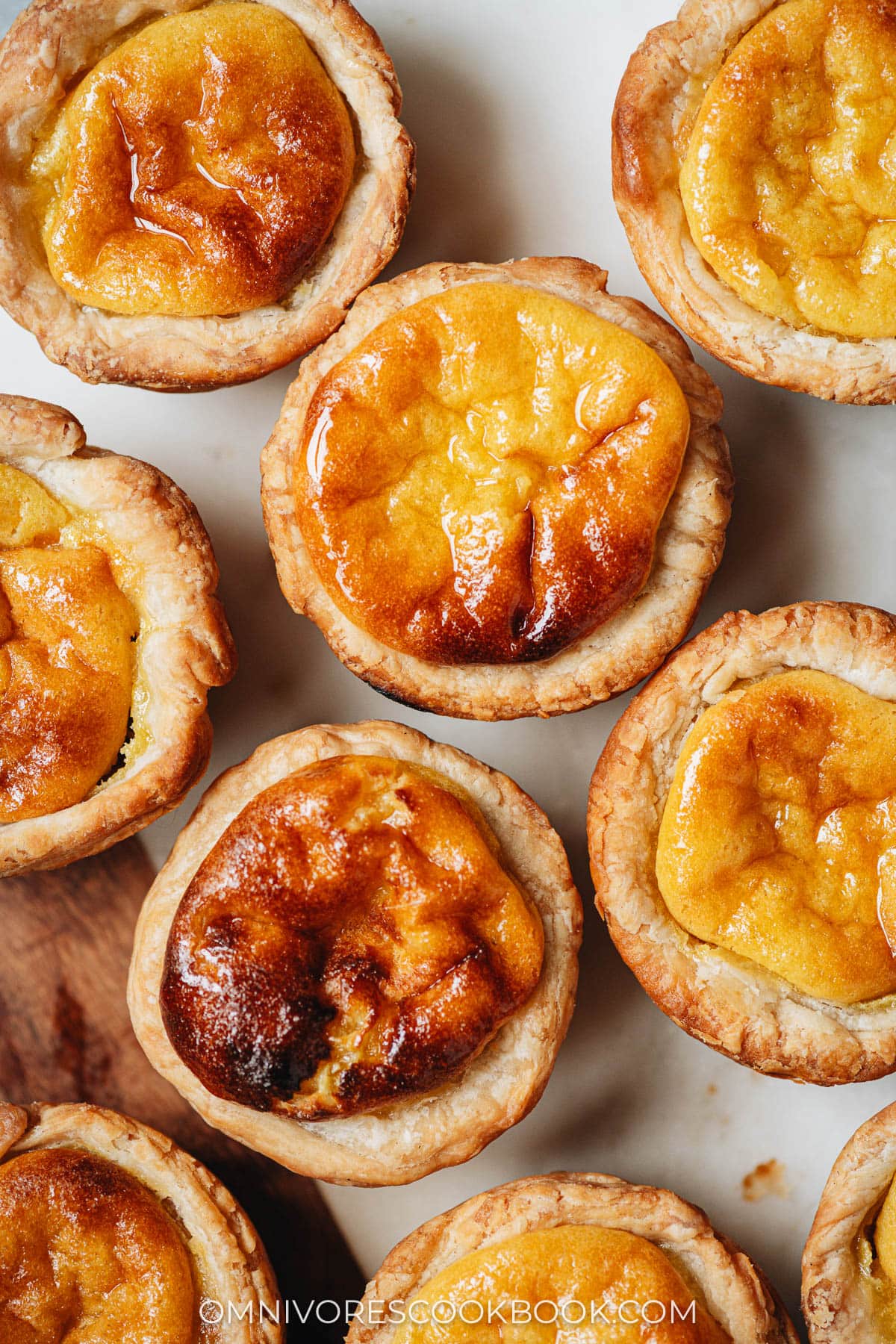
What is Portuguese egg tart
Portuguese egg tart, also known as “Pastel de Nata,” features a layered and flaky crust made from puff pastry, filled with a rich creamy custard. The top is often caramelized, giving it a slightly burnt appearance and a rich flavor.
These delightful tarts were first introduced by the Portuguese in Macau in the late 20th century. Since then, they have become one of the most popular pastries in China.
Why this recipe
Portuguese egg tart was one of my favorite pastries back when I was living in China. After eating it in the US, I was surprised that they were quite different from the version I was familiar with.
Compared to the Portuguese egg tarts in China, the American version is usually much sweeter, the custard is runnier, and the crust is quite thin. On the other hand, the Chinese version features a slightly thicker crust that is more flaky and crispy. The custard is a bit more set, has a rich fragrance of egg and milk, and is mildly sweet.
For me, the Chinese version has a much more balanced texture and flavor profile, which I prefer.
That’s why I worked with my pastry chef Emily Drucker to develop this Portuguese egg tart recipe that ticks all the boxes in my book.
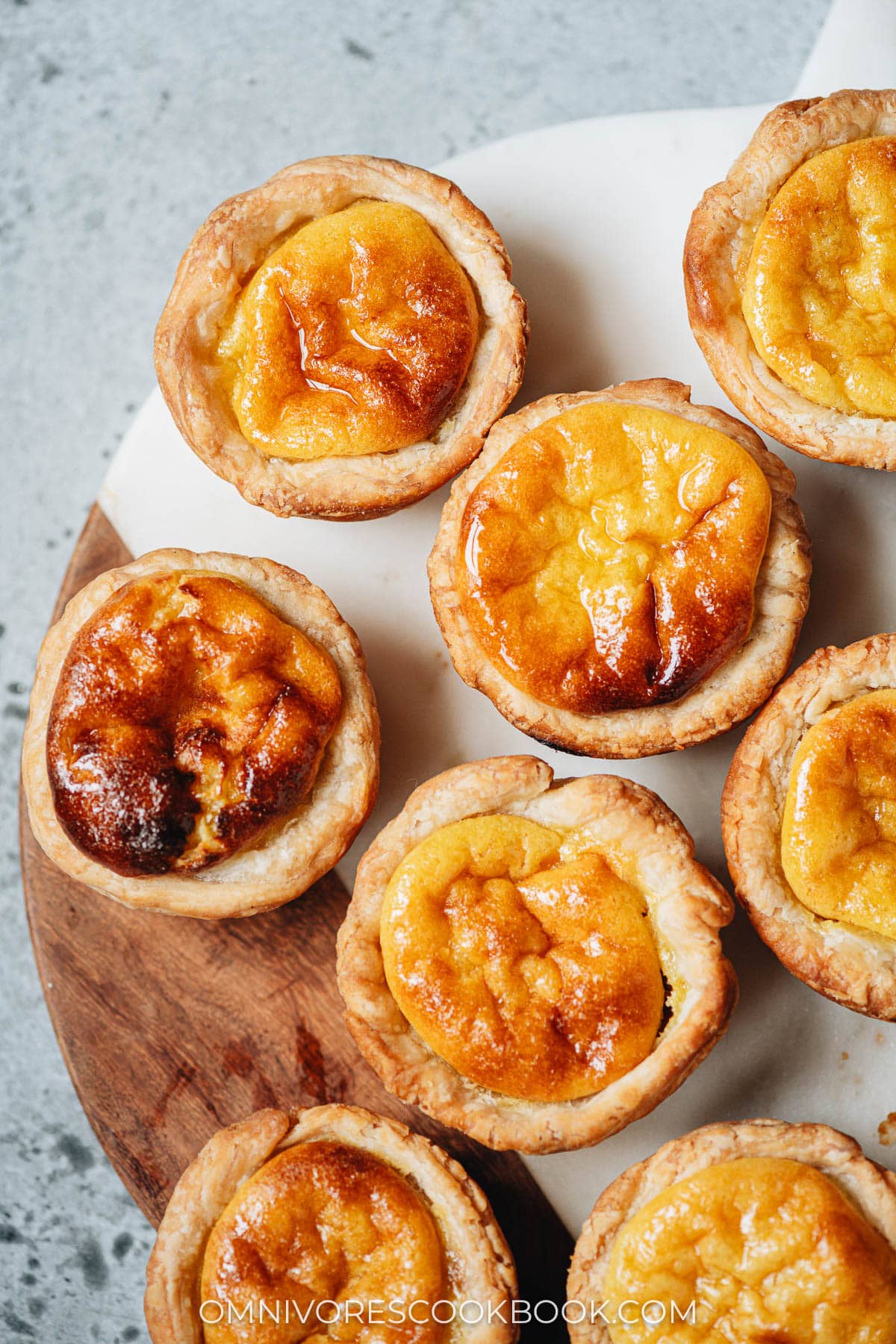
Portuguese egg tart ingredients
Ingredients for the crust
The portuguese egg tart crust consists of just four common pantry ingredients:
- All-purpose flour
- Butter
- Water
- Salt
From these simple ingredients, you’ll be creating a layered pastry dough that makes a super flaky and crispy crust just like professional bakeries.
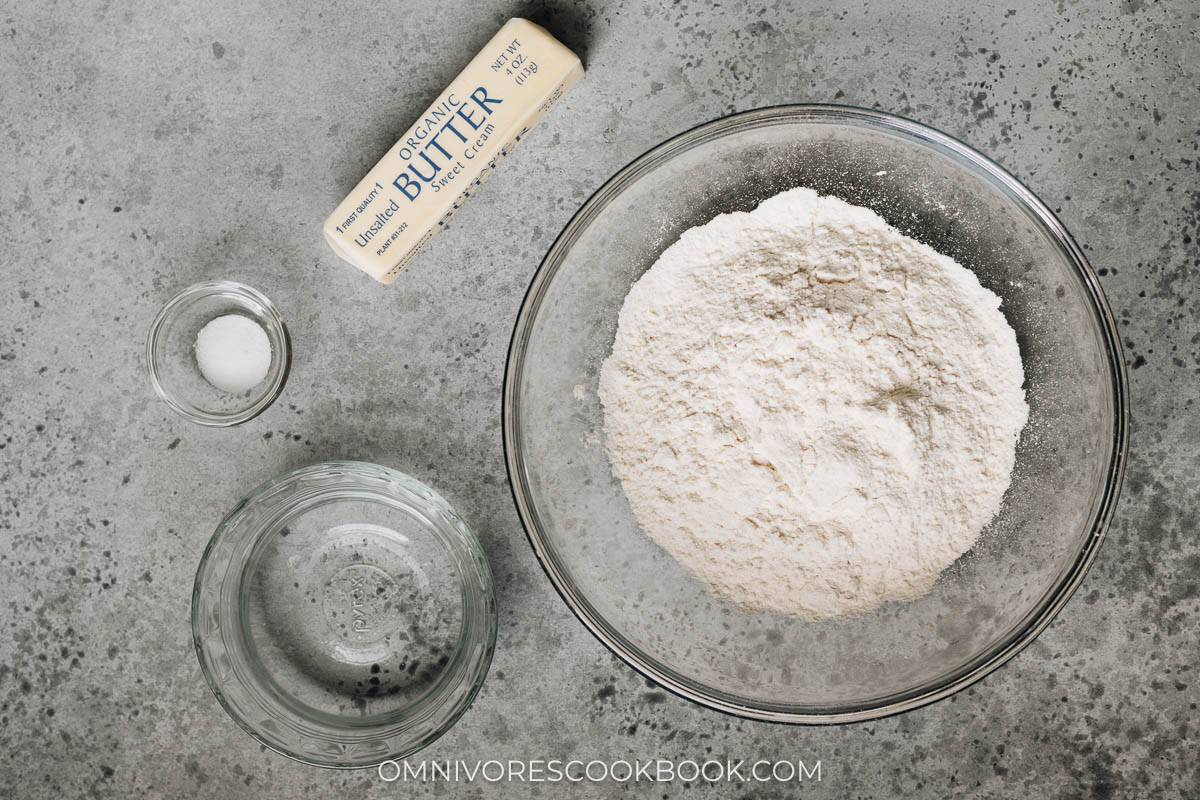
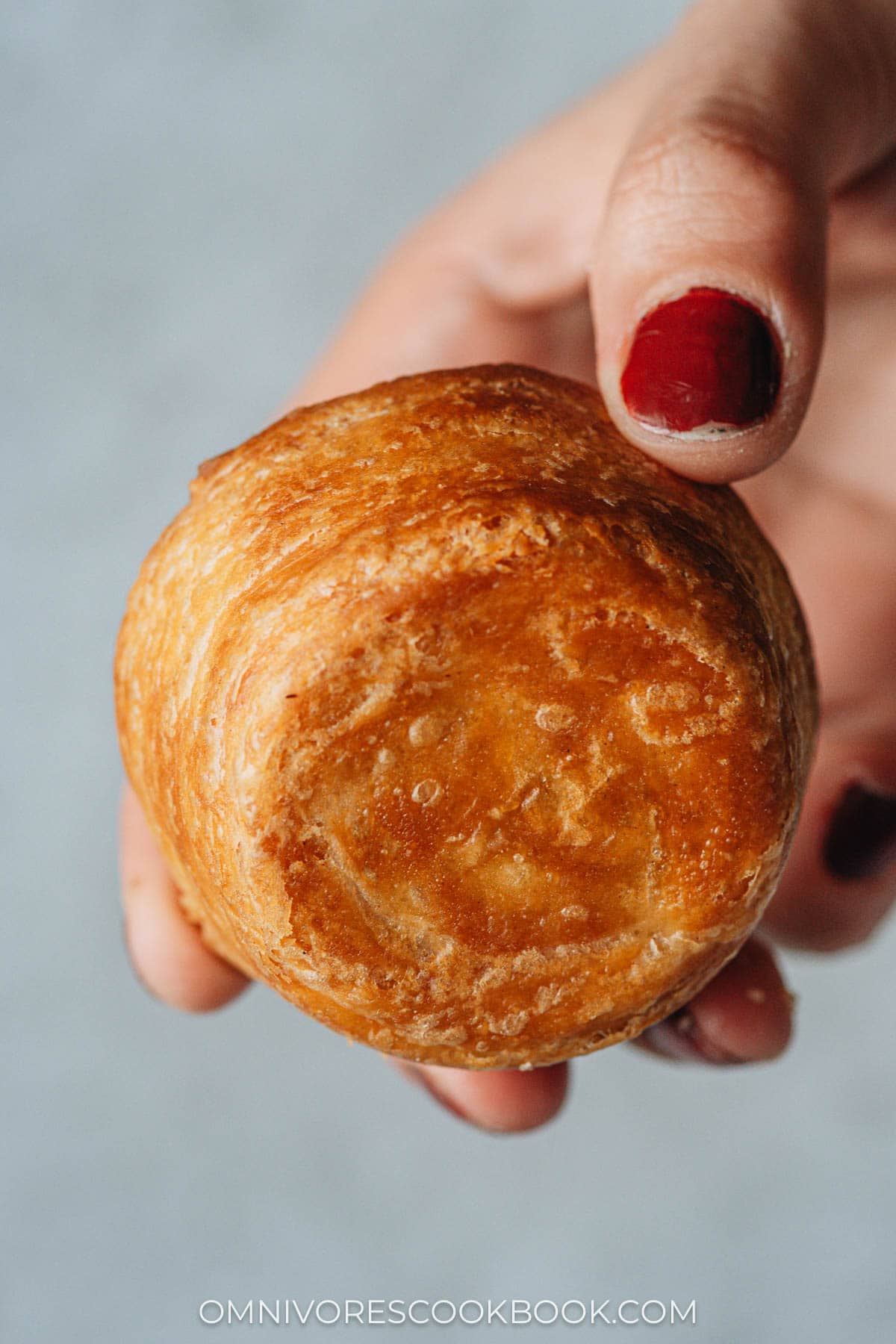
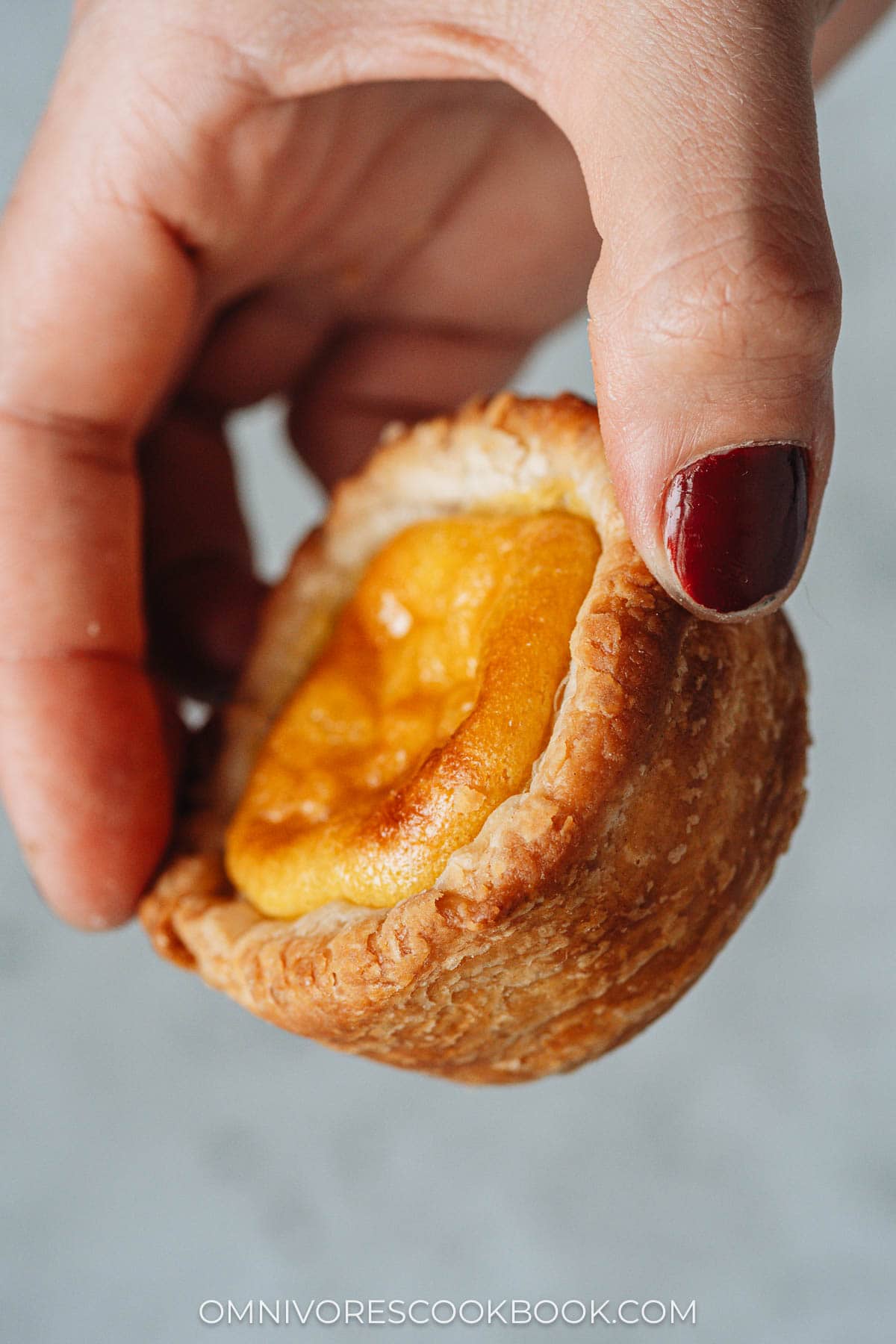
Ingredients for the custard
The ingredients for the custard are quite simple as well and you can probably find everything in your fridge and pantry:
- Milk
- Egg yolks
- All-purpose flour
- Sugar
- Lemon
- Cinnamon sticks
- Water

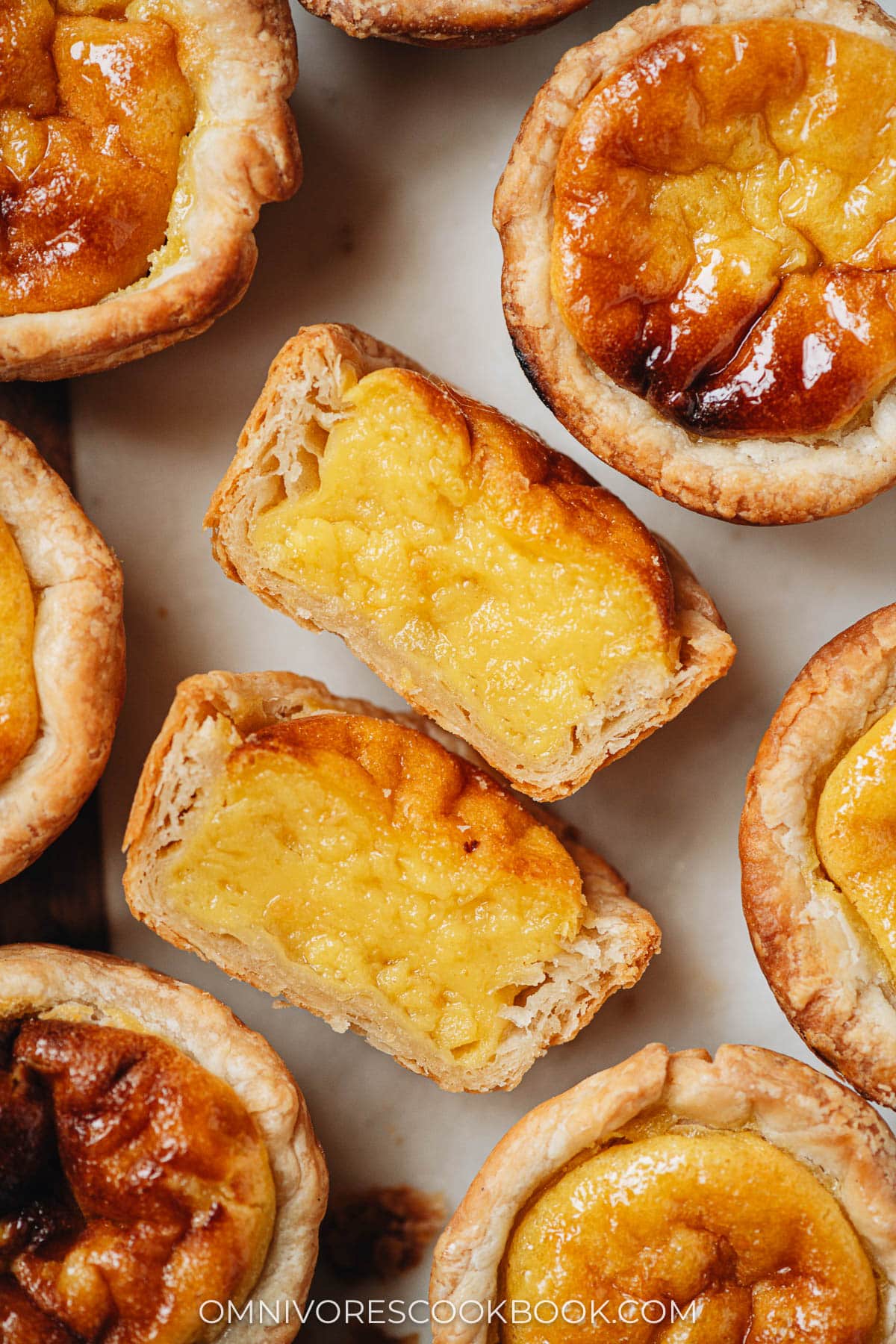
A lot of Portuguese egg tart recipes use vanilla instead of cinnamon sticks. For me, I find the latter flavor more complex and unique. You can use either flavoring method depending on your taste.
This recipe creates a rich, creamy custard that is aromatic and not too sweet. It pairs perfectly with the crispy crust to create a dessert that is irresistible!
How to make Portuguese egg tart
Prepare the dough
- Combine the flour, salt and water
- Mix with a spatula
- Mix until a dough is formed
- Knead the dough briefly
- Let the dough rest for 15 minutes
- The dough will become smooth and sticky
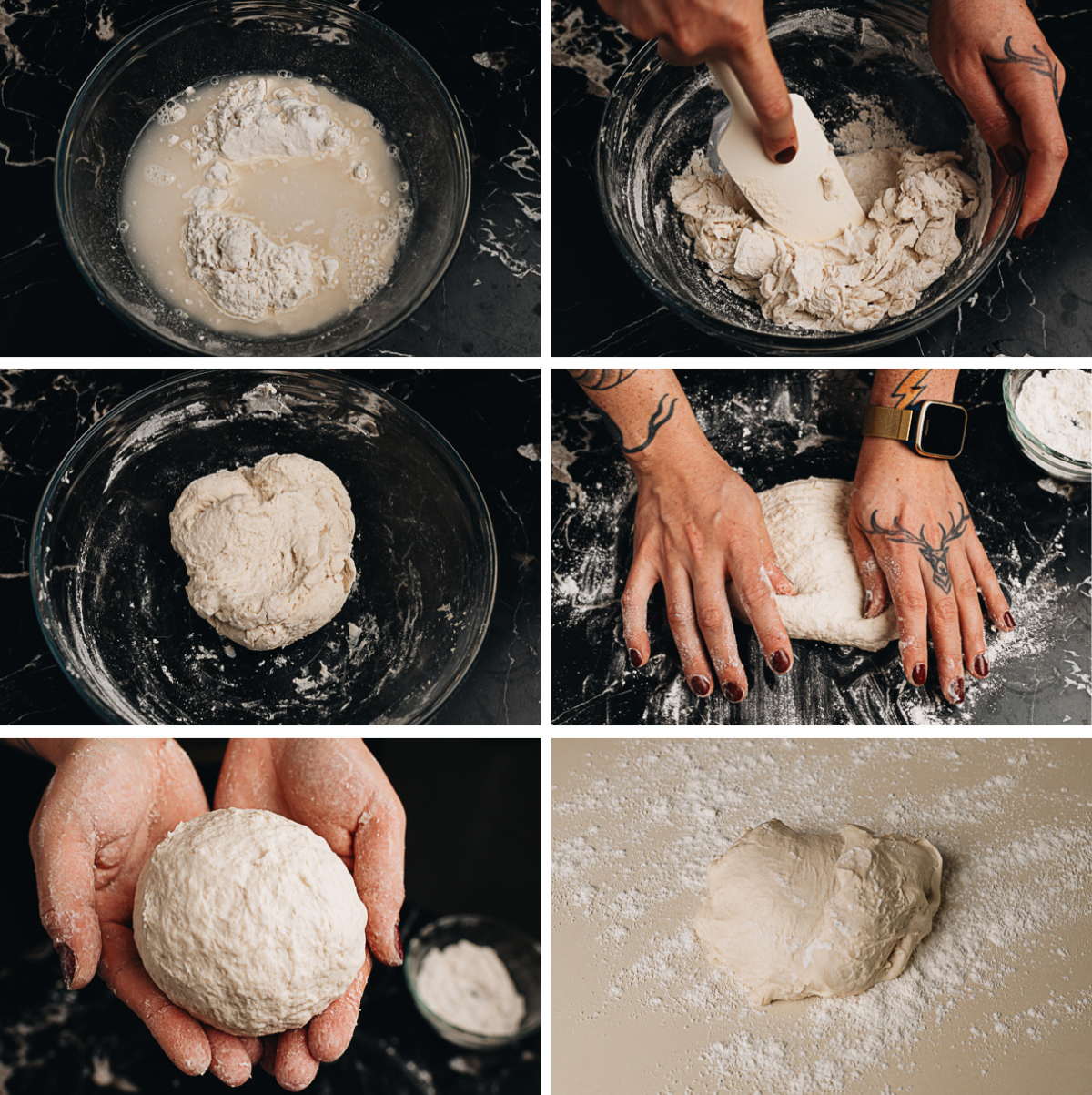
Make the pastry dough – 1st part
- Gently shape the dough into a ball without kneading
- Roll the dough to a large rectangle sheet (the exact size doesn’t matter)
- Spread the softened butter over the dough sheet
- Fold up the lower third of the dough
- Fold down the upper third of the dough
- Rotate the dough 90 degrees
- Roll the dough out into a rectangle
- Brush off excess flour and repeat the same process twice
This way, you’ll have made a pastry dough with many thin layers.
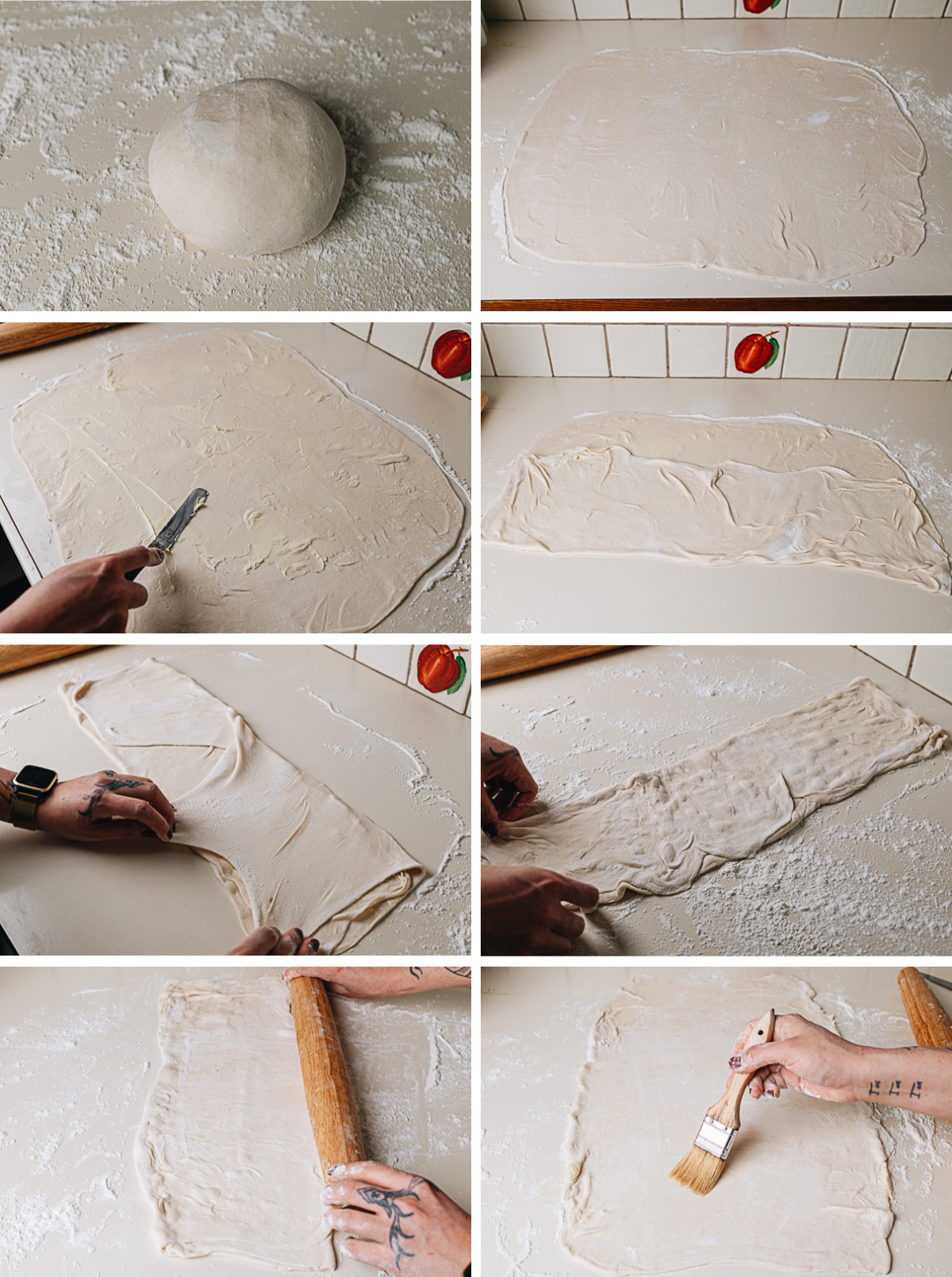
Make the pastry dough – 2nd part
- Trim off the edges of the dough so it’s a large square
- Roll the square into a log
- Gently shape the dough to even it out
- Divide the dough in half (so it’s easier to chill in the fridge)
- You can see the dough is nicely layered
- Cover the dough and transfer it into the fridge to chill for 2 hours
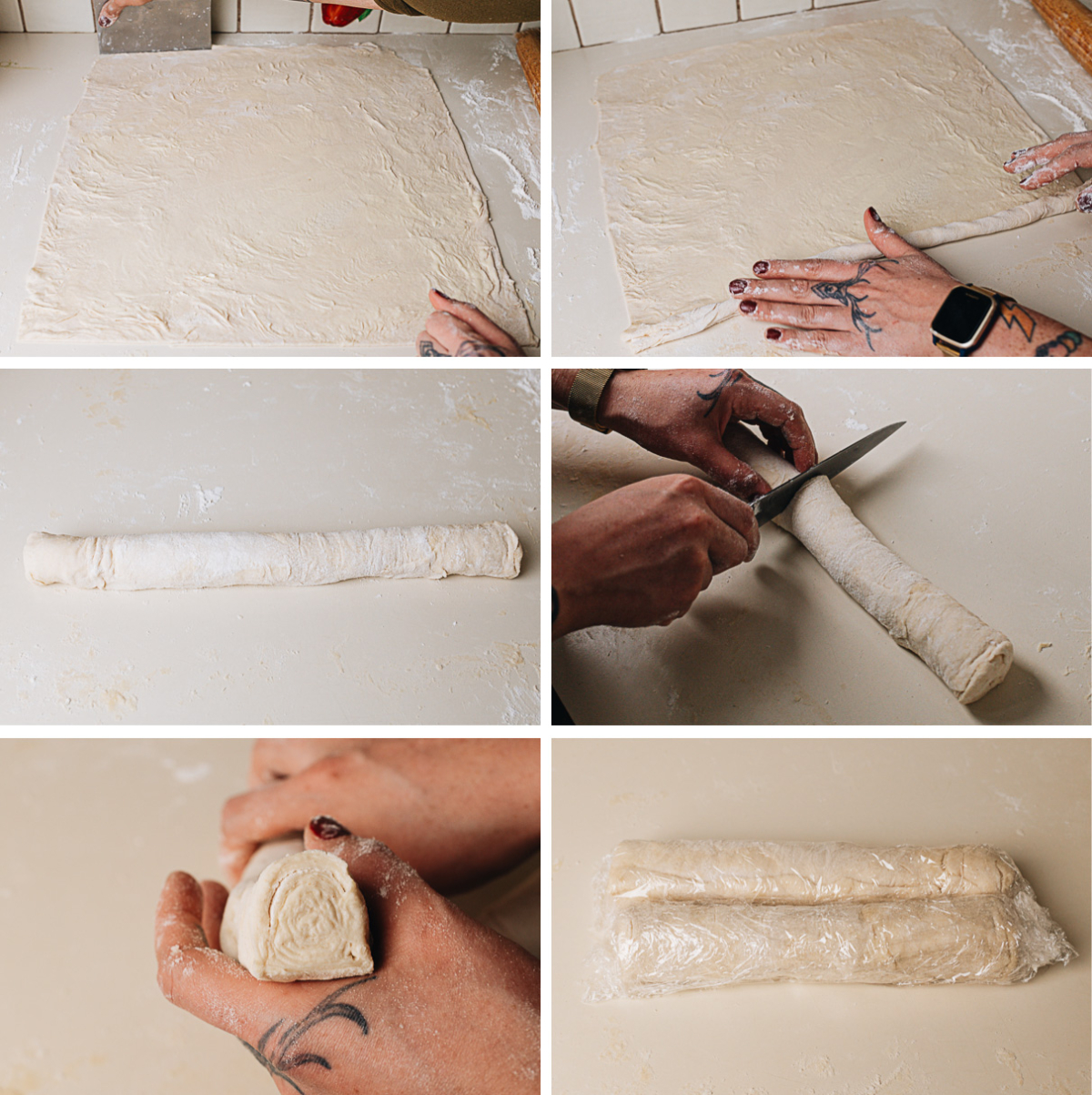
Cook the custard
- Create the syrup by melting the sugar in water with the cinnamon and lemon
- Heat the flour, milk and salt in a saucepan
- Cook and whisk the mixture
- Once thickened, transfer the mixture to cool off slightly
- Strain the syrup into the flour milk mixture
- Whisk to combine
- Add the egg yolk
- Run the mixture through a strainer for a smooth texture
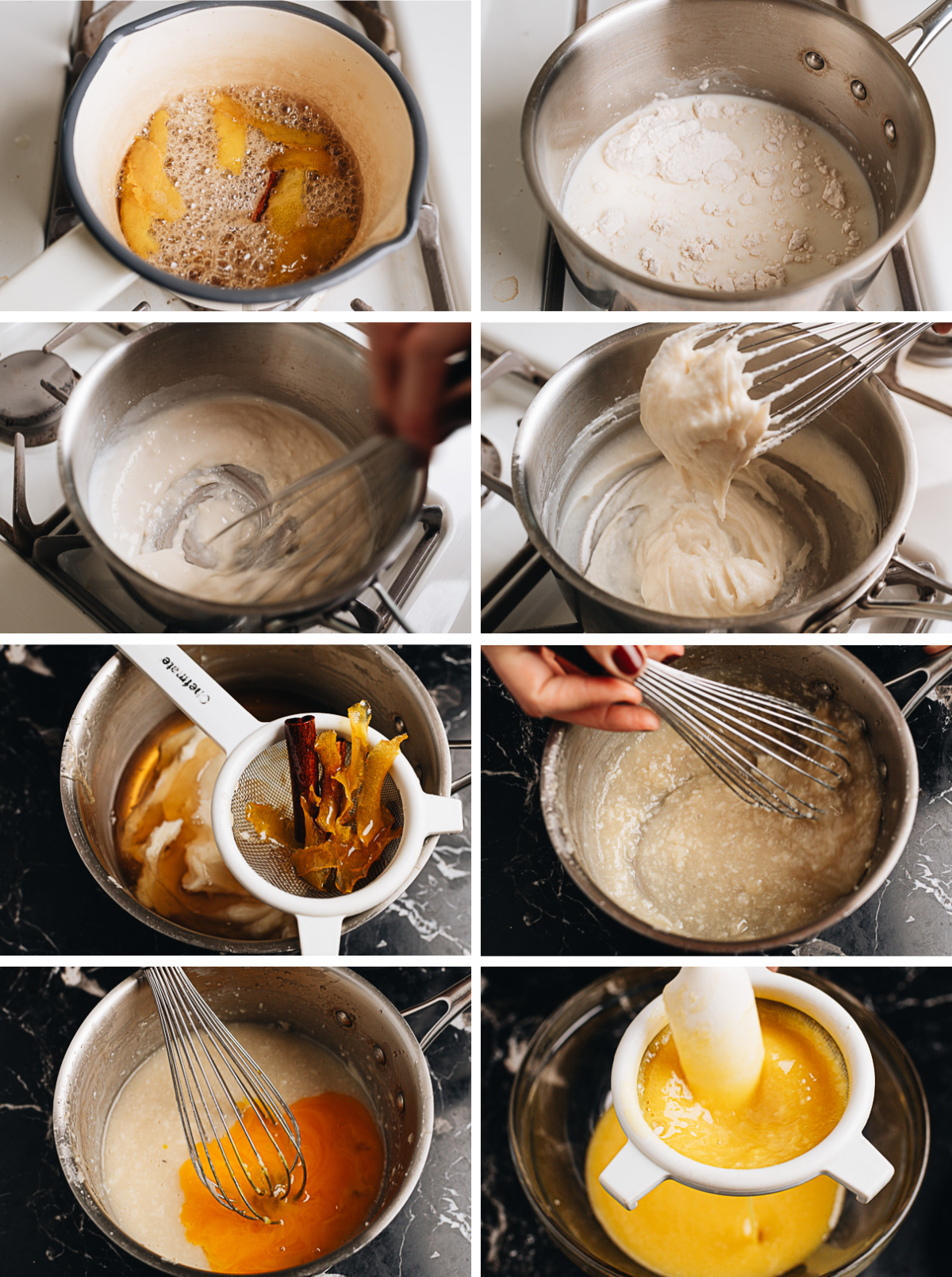
Assemble the egg tarts and bake
- Divide each pastry dough log into 5 pieces (so you get 10 total)
- Dip the cut sides in the flour
- Roll the dough into a round disk
- Press the dough into a muffin tin
- Fill the dough with custard
- Bake until golden brown
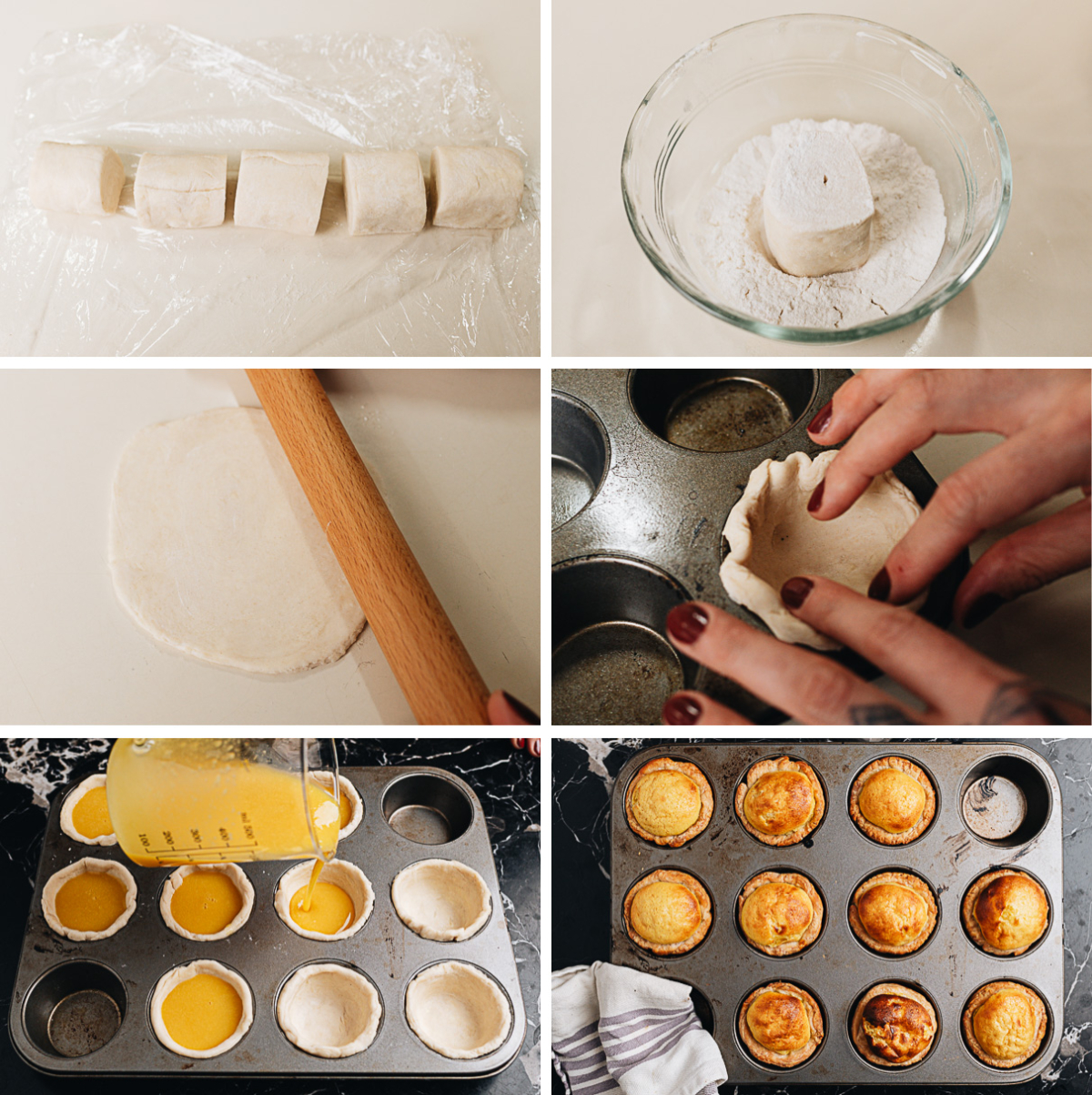
Once baked, you will need to let the egg tarts rest for a few minutes. The top of the tarts will deflate once rested.
Now you can enjoy the tarts while warm, or wait until they’ve cool off to room temperature.
How to store and reheat Portuguese egg tart
Portuguese egg tarts taste the best when they’re fresh out of the oven. If you’re serving them the same day you make them, you can store them loosely covered at room temperature. For longer storage, seal them in a container and store it in the fridge for a few days.
You can always warm up refrigerated egg tarts in the oven before serving.
These Portuguese egg tarts are perfect for breakfast, afternoon tea, and snacks throughout the day. My favorite way is to pair them with a cup of hot tea.
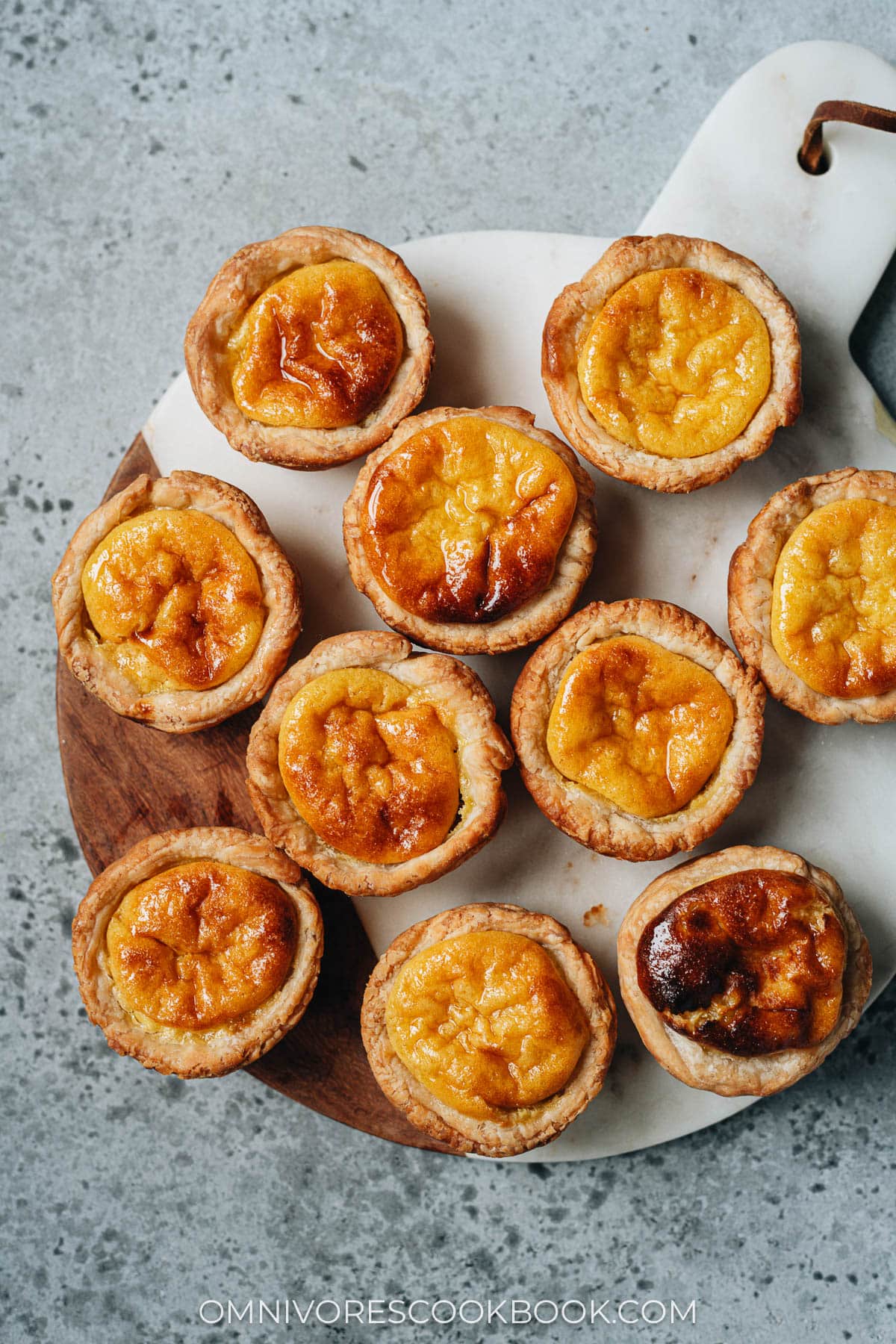
Common questions
Why does my egg tart not have the char on the top?
If your oven’s heating element sits on the bottom of the oven, your egg tarts might not caramelize properly. Your best bet is to use a blow torch to brown the top after the tarts are baked.
Do not over bake these tarts to get the top charred. It will result in over cooking the custard and make it less creamy.
What is the difference between Portuguese and Chinese egg tarts?
Chinese egg tarts, or Hong Kong egg tarts, have a shortcrust pastry and a smoother, more gelatinous custard filling. The Chinese version does not have the caramelized top that is characteristic of the Portuguese tart. You can refer to my Hong Kong egg tarts recipe.
How to reheat Portuguese egg tart in an air fryer?
You can heat up the egg tarts at 300°F in the air fryer for a couple of minutes to warm them through before serving.
Other delicious Chinese bakery recipes
- Pineapple Cake (凤梨酥), A Simplified Version
- Taro Bread
- Chinese Walnut Cookies (核桃酥)
- Red Bean Bread (豆沙包)
- Coconut Mochi (糯米滋, Lo Mai Chi)
Chinese Cooking Made Easy
Are you new to this website? This free email series is a great place to start. I’ll walk you through a few of my most popular recipes and show you how and why they work. You’ll quickly start to cook better Chinese food in your own kitchen.
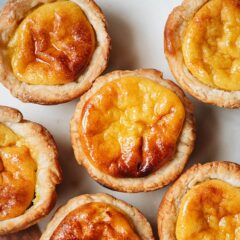
Portuguese Egg Tart (葡式蛋挞, Pastel de Nata)
Ingredients
Dough
- 215 g (1 1/3 cups) all-purpose flour
- 1/4 teaspoon salt
- 150 g (1/2 cup + 2 tablespoons) water
- 1 stick (113 g) unsalted butter , very softened (*Footnote 1)
Filling
- 40 g (1/3 cup) all-purpose flour
- 1/2 teaspoon salt
- 1 cup (240 ml) milk
- 5 egg yolks
- Peels of 1 lemon (or 1 teaspoon lemon extract)
- 2 cinnamon sticks (or 1/4 teaspoon ground cinnamon)
Syrup
- 140 g (1/2 cup + 2 tablespoons) sugar
- 57 g (1/4 cup) water
Instructions
Prepare the dough
- Add the flour and salt into a medium-sized bowl and stir to mix well. Pour in the water. Mix with a spatula until the water has fully incorporated and a dough starts to form.
- Lightly dust a clean work surface. Turn the dough onto the surface. Knead briefly, 5 minutes or so, until it forms a ball with a slightly coarse surface. Place the dough back into the bowl and cover with plastic wrap or a damp towel. Let rest for 15 minutes. The dough will become smooth and very sticky.
Make the pastry
- Dust the working surface with flour again. Turn the dough onto the surface. Gently shape the dough into a ball without kneading (to avoid developing gluten). Then roll the dough into a thin large rectangle sheet, about 1/8” thick.
- Using a small offset spatula, spread 1/3 of the butter all over the surface of the dough, leaving a 1” border at the edges. It’s okay if there’s a few small tears at this step, or if the butter doesn’t spread perfectly evenly.
- Fold the bottom third of the dough up to cover the middle third, and then fold the remaining top third down so it covers the first folded part. Rotate the dough 90°, adding more flour as necessary to avoid sticking.
- Repeat rolling and folding process a second time. If at any point there is excess flour on the top of the dough before adding butter, brush off lightly with a pastry brush.
- Turn the folded dough another 90°, and repeat this one more time with the last third of the butter.
- With the long side of the dough facing you, roll the sheet once again into a rectangle, about 1/8” thick. Trim 1/2” from all edges to even the sides of the dough.
- Roll dough away from you, into a log, and then gently shape it with your hands to even it out.
- Cut the log in half with a sharp knife, and wrap both halves in plastic. Refrigerate for 2 hours, or freeze for 1 hour, until firm.
Make the syrup
- Combine the sugar, water, lemon peel, and cinnamon stick in a saucepan. Bring to boil for 1 minute, and remove from heat to cool. If using lemon extract and ground cinnamon, this can be added once the syrup is removed from heat.
Make the custard
- In another medium-sized saucepan, add the flour, milk, and salt. Cook over medium heat, whisking constantly until thickened, 3 minutes or so. Set aside to cool for at least 10 minutes.
- Once the flour milk paste mixture has cooled off, place a small strainer over the pot. Pour in the syrup over the strainer, then discard the lemon peels and cinnamon. Whisk to mix the syrup.
- Add the egg yolk and whisk again, until evenly incorporated.
- Place a small strainer over a large measuring cup or a bowl with a pouring spout. Pour the custard mixture through the strainer. Use a spatula to push any residual pieces through the strainer. You might want to repeat this step to get a more smooth and even mixture.
Assemble and cook the egg tarts
- Preheat the oven to 425°F (218°C). Cut each dough log into 1 1/4” (3 cm) pieces, creating 10 pieces in total.
- Dip the cut ends of pieces in flour to lightly coat, and with the cut side facing up. Press then roll it with a rolling pin to form an even circle, about 3” (7.5cm) inches in diameter. Firmly press the dough into an un-greased muffin tin, smooth and press it from the bottom to the top, until the dough reaches just over the top edges. Repeat with the remaining dough pieces.
- Fill the pressed dough pieces about 3/4 full with the custard.
- Bake at 425°F (218°C) for 15 to 20 minutes, rotating halfway through, until custard is set and pastry is light brown on edges. Turn the oven up to 500°F (260°C) and continue baking for 5 more minutes, until the pastry is golden brown and the custard has dark, blistered patches. Note, depending on the location of your oven’s heating element, the custard might not brown evenly. To achieve the best char result, you might need to use a blowtorch after baking the egg tarts.
- Once the egg tarts are cooked, transfer the muffin tin to a cooling rack. Allow to cool a bit before removing the egg tarts. Enjoy the tarts still warm or at room temperature.
- (Optional) You can sprinkle the egg tarts with a mixture of 1 tablespoon granulated sugar + 1 teaspoon ground cinnamon as garnish.
Store and reheat
- Store the egg tarts in an airtight container in the fridge for 3 to 4 days. Reheat in a 400°F (200°C) oven for 5 to 10 minutes, to slightly warm up the tarts before serving. Do not freeze the egg tarts.
Notes
- The butter needs to be very soft but not melted. You will be spreading the butter over a very thin and soft dough. The very soft butter will ensure that you can spread it into a thin layer without breaking the dough.
Nutrition

Did you make this recipe?
I’d love to hear how it turned out for you! Please take a moment to leave a 5-star rating ⭐️ and share your thoughts in the comments further down the page. It really helps others discover the recipe too.

Christine S
Hi! Can you clarify the amount of water for the syrup? 57 grams of water is about 1/4 cup, not 1/2 cup.
Maggie Zhu
Sorry about the typo. It should be 57 g (1/4 cup). I’ve updated the recipe to reflect the correct measurement.